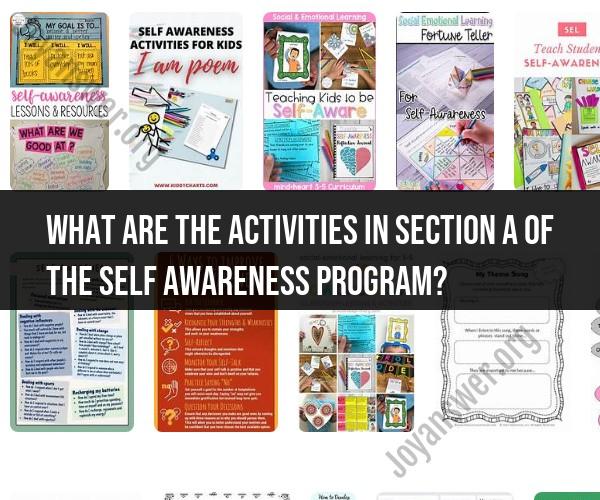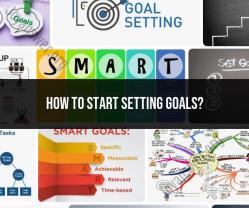What are the activities in section a of the self awareness program?
The specific activities in Section A of a self-awareness program can vary widely depending on the program's design, goals, and the facilitator or organization leading the program. However, Section A typically focuses on foundational activities aimed at helping participants develop self-awareness. Here are some common activities that might be included in Section A of a self-awareness program:
Self-Reflection Exercises:
- Journaling: Participants may be encouraged to keep a journal to record their thoughts, feelings, and experiences.
- Mindfulness Meditation: Guided mindfulness exercises can help individuals become more aware of their thoughts and emotions.
Personality Assessments:
- Administering personality assessments like the Myers-Briggs Type Indicator (MBTI) or the Big Five Personality Traits can help individuals gain insights into their personality traits and preferences.
Strengths and Weaknesses Analysis:
- Participants can identify their strengths and areas for improvement through self-assessment and feedback from others.
Values Clarification:
- Activities to help individuals identify and prioritize their core values, which can guide decision-making and goal-setting.
Emotional Intelligence Exercises:
- Activities to enhance emotional intelligence, including recognizing and labeling emotions, understanding triggers, and practicing empathy.
Self-Awareness Surveys:
- Using self-assessment surveys or questionnaires to prompt reflection on various aspects of one's life, such as work-life balance, stress levels, and personal goals.
Feedback and Self-Perception Gap Analysis:
- Encouraging participants to solicit feedback from colleagues, friends, or family members and compare it to their self-perception to identify any gaps or discrepancies.
Goal Setting:
- Setting clear, specific, and achievable personal development goals based on self-awareness insights.
Group Discussions:
- Facilitating group discussions where participants can share their self-awareness insights, challenges, and growth experiences.
Visualization Exercises:
- Guided visualization activities to help participants imagine their ideal self and future, which can aid in goal-setting and motivation.
Values Exploration:
- Activities that involve exploring personal values and how they align with various aspects of life, including career, relationships, and personal growth.
Identity Mapping:
- Creating identity maps or diagrams to visually represent various aspects of one's identity, such as roles, values, and beliefs.
Please note that the activities in Section A may be tailored to the specific goals of the self-awareness program and the needs of the participants. Participants may progress through these activities at their own pace, and the program may include additional sections or stages focused on further self-awareness development and personal growth.
Section A of the Self-Awareness Program: Activities and Insights
Section A of the self-awareness program is typically focused on helping participants to develop a better understanding of themselves, their thoughts, feelings, and behaviors. This may involve activities such as:
- Identifying and understanding your emotions. This may include learning about the different types of emotions, how to identify your own emotions, and how your emotions affect your thoughts and behaviors.
- Exploring your values and beliefs. This may involve reflecting on your core values, what is important to you in life, and how your values and beliefs influence your decisions and actions.
- Identifying your strengths and weaknesses. This may involve taking personality assessments, reflecting on your past experiences, and asking for feedback from others.
- Understanding your personal style. This may involve identifying your communication style, conflict resolution style, and decision-making style.
Self-Awareness Program Breakdown: What to Expect in Section A
Section A of the self-awareness program may be delivered in a variety of formats, including workshops, seminars, online courses, and individual coaching sessions. The specific activities and exercises that are included will vary depending on the program and the facilitator.
However, in general, Section A of the self-awareness program can be expected to provide participants with the opportunity to:
- Learn about the different aspects of self-awareness.
- Reflect on their own thoughts, feelings, and behaviors.
- Identify their strengths and weaknesses.
- Develop a better understanding of their personal style.
- Begin to develop strategies for improving their self-awareness skills.
Personal Growth Journey: Activities in Section A of Self-Awareness
The activities in Section A of the self-awareness program can be a valuable tool for personal growth and development. By taking the time to learn more about yourself, you can develop a better understanding of your strengths and weaknesses, identify your goals and values, and make more informed decisions about your life.
Here are a few examples of activities that you may encounter in Section A of a self-awareness program:
- Emotion wheel: This exercise can help you to identify and understand your emotions.
- Values clarification: This activity can help you to clarify your core values and what is important to you in life.
- SWOT analysis: This exercise can help you to identify your strengths, weaknesses, opportunities, and threats.
- Personality assessment: This can help you to understand your personality type and how it influences your thoughts, feelings, and behaviors.
- Personal style assessment: This can help you to understand your communication style, conflict resolution style, and decision-making style.
If you are interested in developing your self-awareness, there are many resources available to help you. You can find self-awareness programs online, in person, or through individual coaching. You can also find many books and articles on the topic of self-awareness.
By investing in your self-awareness development, you can improve your personal and professional relationships, increase your resilience, and achieve greater success in all areas of your life.







